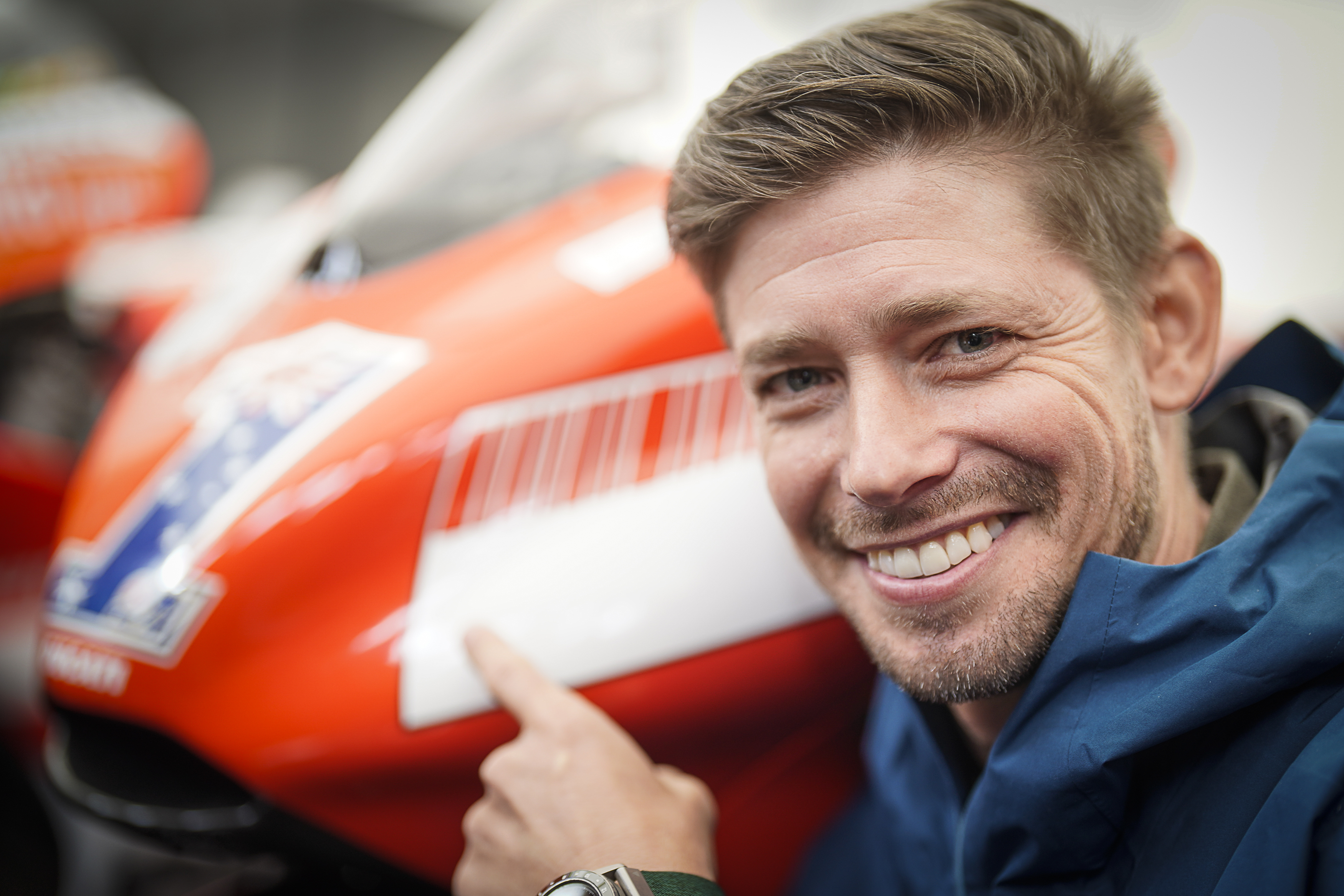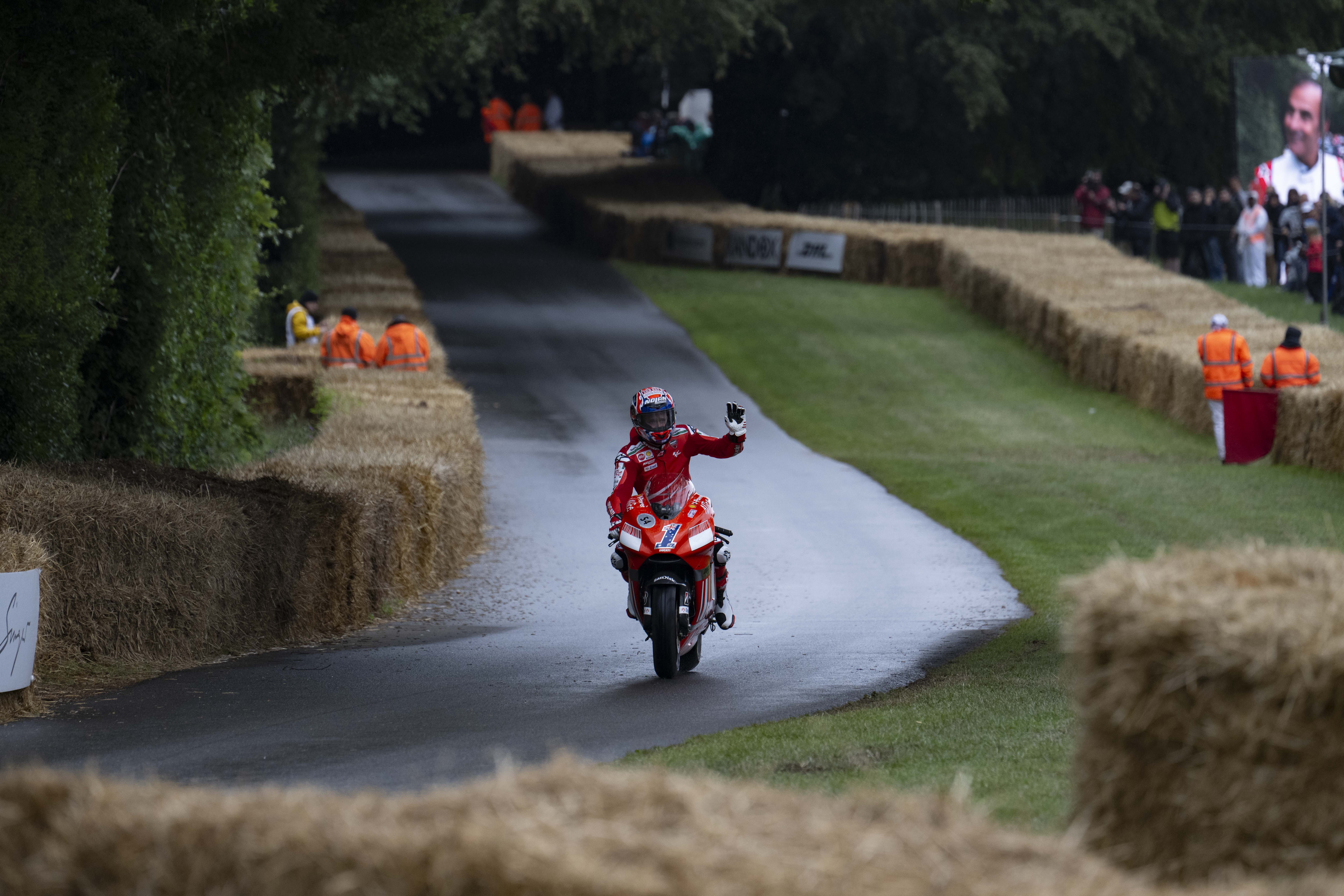Two-time champion Casey Stoner says MotoGP has descended into “clone wars” and needs radical changes to its technical rulebook to improve its racing and reverse its popularity decline.
Stoner’s passion hasn’t wavered since his shock retirement from MotoGP at the end of 2012 and he’s never been afraid of airing his views on the issues he sees with the championship.
His latest call for change comes while he’s at the Goodwood Festival of Speed, where he is riding his 2007 championship-winning Ducati Desmosedici up the famous hillclimb.
But his former employer Ducati comes under indirect fire in Stoner’s strong opinion on what has to be done to fix MotoGP.
“I’d like to make some changes,” he said. “Winglets, gone. Ride height devices, gone. Anti-wheelie, gone. Traction control cut to a safety level and nothing more. Half this s*** needs to go, needs to come down.
“There needs to be a cap on the rules that’s there for 10 years, so that manufacturers can reasonably catch up to each other and not keep moving this imaginary rule system that doesn’t really seem to be there.
“Even when I was there, I remember people saying ‘oh we can change the rules to fit that.’ What’s the point of a rulebook if you can change it?
“All of this stuff, it’s pushing the price up so far, and you’ve got half the bikes on the grid dictating who’s allowed to beat who. It’s not fair and it’s not the way a world championship should be.”
And while there might be opposition inside the championship to limiting the technical rulebook even further than it already has been, Stoner is adamant that MotoGP should be looking at a lesson given by Formula 1.
Asked whether MotoGP could really go ‘backwards’ with its rulebook in terms of technical progression, he replied “f***ing right you can. F1 did it and took everything away from them [the teams]. Adaptable [active] suspension, gone [from 1994]. Traction control, gone [from 2008].
“You can go backwards, but it needs to set rules that no one can go outside of.
“Rules that don’t change for 10 years so that people know that if they put a plan together and they put their budget together, they can all be within the range.
“Yamaha had a great chassis and a smooth engine, but it had a fault in that they never had a particularly powerful engine. Then you had your bikes with powerful engines that couldn’t put it on the ground. Everyone had pros and cons.
“Now, you have clone wars. Everyone just has to copy the same f***ing thing and go in the same direction. You don’t see pros and cons any more.
“We’ve got this incredible slow-motion photography that’s an incredible waste of time, because you’re just watching a bike go through a corner.

“There’s no wheelieing, no shaking, no someone showing incredible control. You just come out, twist the throttle, and nothing is going to happen. Come on! It’s frustrating me, because as much as I love the sport and love the racing side of the sport, it disappoints me to see how far it has gone.
“Not only does all of this stuff cost a lot to develop, it costs a lot when they crash it, and it’s just blowing budgets out of proportion. Look at the ride height device. If everyone’s got it, and everyone does the exact same thing. Get rid of it. Let people make mistakes coming out of corners. We don’t want a single-bike championship, we want differences.
“The only thing they can do these days is brake later, take more risk on the front end trying, and then you see big crashes because everyone is pushing so much in the corners.”
Always a purist even in his own time racing in the series, Stoner thinks the solution is obvious: dialling back rider aids in particular to a level where they remain a safety net for racers but place more emphasis on a rider’s skill and reduce the reliance on electronics to do the hard part for them.
“It’s stupid,” he said of electronic rider aids. “Get rid of it. Or if you’re going to have it, at least have it as a safety net, not at a competitive level. That’s all it needs to be, a safety buffer not something that absolutely dominates.
“We had way too many electronics when I was there and I didn’t enjoy it. I like the artistry of simple things: short-shifting, finding traction in what you’ve got. I like finding mechanical grip, finding the pitch, getting the balance right.
“Throw in a heap of electronics and all of a sudden the bike becomes easier, but in the past there was always that pro and con thing. Power is one thing, but rideability is another, and you get those two things fighting against each other on track. Now, everyone’s just in that same kind of field.

“I think 2006 or maybe 2007 was the last limit of traction control we should have. Maybe more refined so that it doesn’t just shut off and launch you to the moon, but it should always be worse than just staying inside of it.
“It was the same with wheelieing. It would always cut in at a certain height, so it was always better to stay under that height because there was no flow or momentum to it. It should be there as that safety buffer but without giving you a competitive advantage.”
And should series promoter Dorna need an expert opinion to help guide the changes that Stoner believes it needs to make it, he’s not averse to helping out with advice.
That’s a big change from the Stoner of the past who regularly hinted that he wanted little to do with the MotoGP paddock following his retirement.
“On certain aspects, yes,” he told The Race when he asked if he was the man for the job, “but I’m very cautious to get into a position where all of a sudden they’re using me as a voice that they’re able to manipulate, to take me out of the way. I’d rather cause more problems being on the outside with an outside perspective.
“That’s something I feel I can bring to the table, because I’m not locked into something seeing slow progression – I’m on the outside seeing these big chunks of change over the years.

“If it was the right situation with the right contract, where I had enough power, then I’d love to make some changes.
“It is hard – I’ve been there. But I’d like to be there for the right amount of time, to make the changes taking in everyone’s perspective.
“You’ve got to take the manufacturers’ perspective, but what they’re not doing right now is taking in the riders’ perspective.
“For me the show, the danger, the more accidents we’re seeing these days, it’s ridiculous.”






